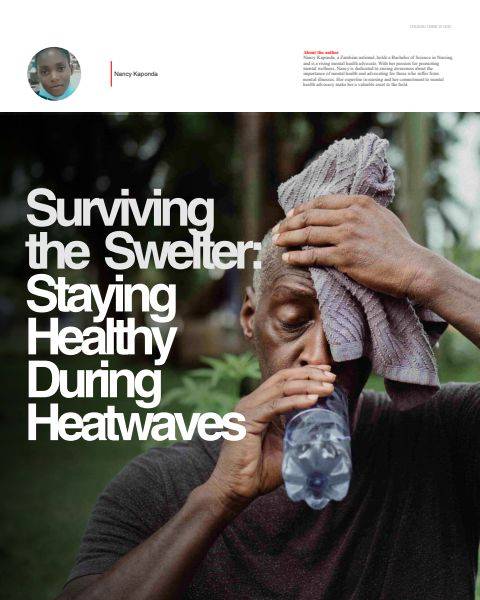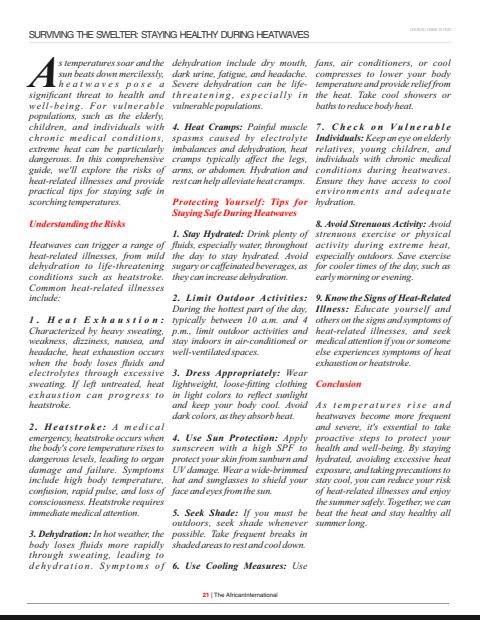By Nancy Kaponda

As temperatures soar and the sun beats down mercilessly, heatwaves pose a significant threat to health and well-being. For vulnerable populations, such as the elderly, children, and individuals with chronic medical conditions, extreme heat can be particularly dangerous. In this comprehensive guide, we’ll explore the risks of heat-related illnesses and provide practical tips for staying safe in scorching temperatures.
Understanding the Risks
Heatwaves can trigger a range of heat-related illnesses, from mild dehydration to life-threatening conditions such as heatstroke. Common heat-related illnesses include:

1. Heat Exhaustion: Characterized by heavy sweating, weakness, dizziness, nausea, and headache, heat exhaustion occurs when the body loses fluids and electrolytes through excessive sweating. If left untreated, heat exhaustion can progress to heatstroke.
2. Heatstroke: A medical emergency, heatstroke occurs when the body’s core temperature rises to dangerous levels, leading to organ damage and failure. Symptoms include high body temperature, confusion, rapid pulse, and loss of consciousness. Heatstroke requires immediate medical attention.
3. Dehydration: In hot weather, the body loses fluids more rapidly through sweating, leading to dehydration. Symptoms of dehydration include dry mouth, dark urine, fatigue, and headache. Severe dehydration can be life-threatening, especially in vulnerable populations.
4. Heat Cramps: Painful muscle spasms caused by electrolyte imbalances and dehydration, heat cramps typically affect the legs, arms, or abdomen. Hydration and rest can help alleviate heat cramps.
Protecting Yourself: Tips for Staying Safe During Heatwaves
1. Stay Hydrated: Drink plenty of fluids, especially water, throughout the day to stay hydrated. Avoid sugary or caffeinated beverages, as they can increase dehydration.
2. Limit Outdoor Activities: During the hottest part of the day, typically between 10 a.m. and 4 p.m., limit outdoor activities and stay indoors in air-conditioned or well-ventilated spaces.
3. Dress Appropriately: Wear lightweight, loose-fitting clothing in light colors to reflect sunlight and keep your body cool. Avoid dark colors, as they absorb heat.
4. Use Sun Protection: Apply sunscreen with a high SPF to protect your skin from sunburn and UV damage. Wear a wide-brimmed hat and sunglasses to shield your face and eyes from the sun.
5. Seek Shade: If you must be outdoors, seek shade whenever possible. Take frequent breaks in shaded areas to rest and cool down.
6. Use Cooling Measures: Use fans, air conditioners, or cool compresses to lower your body temperature and provide relief from the heat. Take cool showers or baths to reduce body heat.
7. Check on Vulnerable Individuals: Keep an eye on elderly relatives, young children, and individuals with chronic medical conditions during heatwaves. Ensure they have access to cool environments and adequate hydration.
8. Avoid Strenuous Activity: Avoid strenuous exercise or physical activity during extreme heat, especially outdoors. Save exercise for cooler times of the day, such as early morning or evening.
9. Know the Signs of Heat-Related Illness: Educate yourself and others on the signs and symptoms of heat-related illnesses, and seek medical attention if you or someone else experiences symptoms of heat exhaustion or heatstroke.
Conclusion
As temperatures rise and heatwaves become more frequent and severe, it’s essential to take proactive steps to protect your health and well-being. By staying hydrated, avoiding excessive heat exposure, and taking precautions to stay cool, you can reduce your risk of heat-related illnesses and enjoy the summer safely. Together, we can beat the heat and stay healthy all summer long.
| ReplyReply to allForwardAdd reaction |

